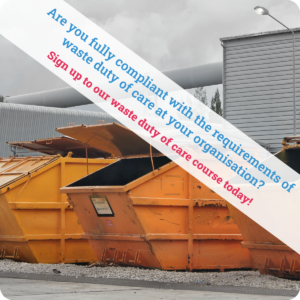It is estimated that businesses in the UK are responsible for the generation of 41.1 million tonnes of commercial and industrial waste every year. Despite this, many organisations struggle with implementing appropriate waste management procedures and in fully understanding their specific duties under waste legislation.
Commercial organisations generate almost twice as much waste as households and waste management can often feel like a burden when there is a business to run and budgets to manage. However, managing waste responsibly is not just a moral environmental consideration, it is required by law.
All businesses have what is known as a legal ‘duty of care’ when it comes to their waste. This means that they have a duty, set out in law, to ensure that their waste is being managed appropriately, without causing harm to people and the environment. Failure to meet this duty can result in prosecution and fines from regulators and irreparable reputational damage to an organisation.
Organisations must therefore make sure that their waste is managed safely and legally and that the correct waste documentation (waste transfer notes or hazardous waste consignment notes) are in place for its movement. It is the responsibility of the organisation producing the waste to ensure that this happens, and that appropriate procedures and checks are put in place to meet these obligations.
Some waste streams are easier to manage than others. General waste, for example is a common waste stream and there is easily accessible information available on how to manage it. However, some less frequently encountered waste streams can trip businesses up when it comes to duty of care and complying with waste legislation.
Below are some common issues faced by many organisations when managing their waste.
All waste must be identified and classified using a 6-digit code (known as an EWC which stands for European Waste Catalogue) before being sent for recovery or disposal. Many wastes are however often misclassified and the wrong EWC code used. For example, waste may be classified as non-hazardous, when it is in fact hazardous. This is common with waste ink and toner cartridges and waste electrical and electronic equipment (WEEE). Guidance is available from the Environment Agency on how to classify different types of waste and should be used to ensure waste is classified correctly.
Waste must always be transported by a registered waste carrier (as authorised by the appropriate environmental regulator) and sent to a facility authorised (by an environmental permit or exemption) to accept that specific waste stream. Organisations must check this before transferring waste to another party – these checks are sometimes referred to as ‘duty of care checks’. Copies of waste carriers registrations and permits can be requested from the waste contractor or checked on the appropriate regulators public register.
No waste stream can be stored on the site it was produced for longer than 12 months. Even if only small quantities of a particular waste stream are generated, it must be collected from site by an authorised waste contractor at least every 12 months.
Many waste streams that are produced infrequently, in small quantities, or managed by a third party are often missed when looking at site waste management. All waste must be considered, including any waste generated by any developments, projects, or contractors. Commonly forgotten waste streams include confidential waste and sanitary waste. All waste produced by an organisation is subject to duty of care requirements and must be collected by a registered waste carrier and have the correct paperwork in place for its removal.
- Organisations have a duty of care responsibility for all waste produced.
- Anyone collecting waste must be registered as a waste carrier with the appropriate environmental regulator.
- Waste can only be taken to a site that has the appropriate authorisation (an environmental permit or exemption) in place to accept it.
- Waste documentation (waste transfer notes or hazardous waste consignment notes) must be in place for all movements of waste.
- No waste should be stored onsite for longer than 12 months.
Are you confident with managing your waste correctly? Would you like to know more about how to comply with your waste duty of care? Why not look at the duty of care support services we offer, or book onto one of our virtual waste duty of care training courses.

